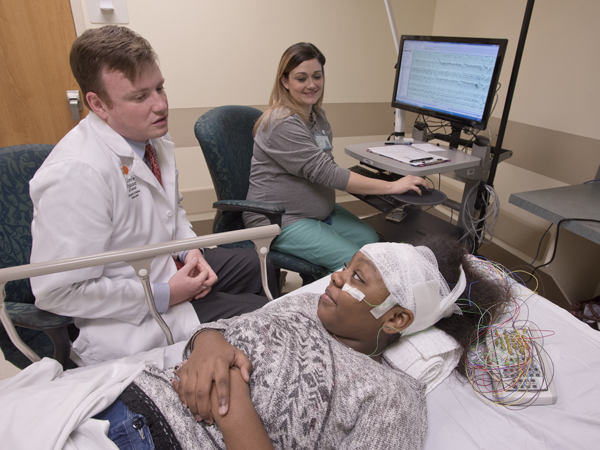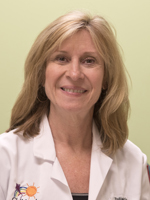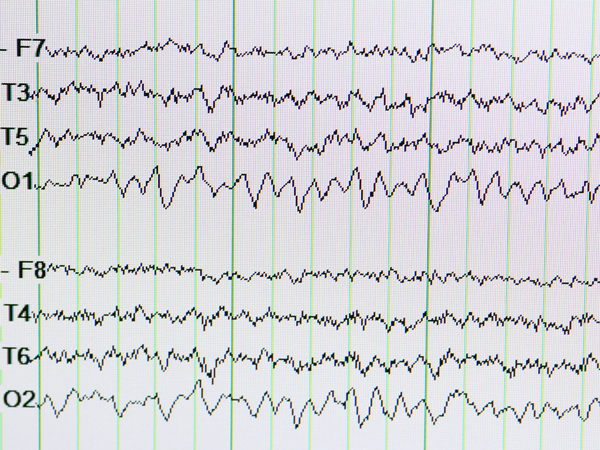New pediatric neurophysiology lab offers child-centered care

Published in News Stories on May 16, 2016
Malaya Gray, a rainbow of EEG wires surrounding her face like a halo, was trying to sleep, a requirement of the monitoring she was undergoing Friday morning.
The 12-year-old Pearl student who's had EEGs before to monitor her epilepsy was having them in a new space. The Pediatric Neurophysiology Lab opened May 2 in a temporary space at 4 Circle in response to increased requests for tests such as EEGs and EMGs for children.
Until this month, pediatric EEGs, which measure electrical activity in the brain, and EMGs, which measure electrical activity produced by skeletal muscles, had been done by the same department that serves adult patients at UMMC.
“I love this,” said Malaya's mother Marietta Gray of the new clinic devoted to young patients. “We've been at Batson Children's Hospital, and we love the treatment there and that it is just for children. We wouldn't want to be anywhere else.”

Gray is wired with leads for her EEG in the new Pediatric Neurophysiology Lab.
Physicians involved say they hope the result of having a lab just for pediatric patients will be faster response time, quicker readings and testing at bedside for children admitted to Batson Children's Hospital or being treated at the Col. Harland Sanders Children's Emergency Department or the Selby and Richard McRae Children's Trauma Unit.
The lab will be housed on 4 Circle until fall, when services will move to permanent space on the ground floor of the state's only children's hospital.
“The parking being easier there will be important for us,” said Dr. Brad Ingram, director of the Pediatric Comprehensive Epilepsy Center, said of the permanent space. “Many of our patients are in wheelchairs, so getting in and out of the car and into the building is more difficult. This will make it a lot easier for families.”
Helping open the lab on 4 Circle was neurophysiology technician Bobbi Jo Burns, who had previously worked in the shared lab. “I love it here,” she said. “I think the best part is knowing the kids will get their tests in a more timely manner.”
Ingram said the shared lab offered good care by skilled professionals. “The techs and nurses have gotten to know each other, and it's been a very amicable relationship.”
But the reality, he said, “is that the neuro population has grown 31 percent in the past two years, but there's been no additions of techs or equipment.”
“We have outgrown having a shared lab,” said Guy Giesecke, CEO of Children's of Mississippi, the umbrella organization that includes Batson Children's Hospital and all UMMC pediatric care. “While the care was good before, we felt that it was better for patients and families to have a pediatric neurophysiology lab that was designated and oriented for children.”

Parker
“This has been a dream of ours for a long time,” said Dr. Collette Parker, professor of pediatric neurology, “and there has been a huge increase in demand in the state for a pediatric neurophysiology lab.”
There is no exact number to reflect the rate of pediatric epilepsy in the state, but nationally, one in 26 people will develop epilepsy at some point in their lives. While anyone could develop the condition, Ingram said the risk of epilepsy is increased in cases of low birth weight. Mississippi's rate of pre-term births is among the highest in the country.

Electrical activity in the brain is measured with EEGs.
The new pediatric neurophysiology lab will include five technologists for EEGs and EMGs, who will test outpatients in the lab and, for children in hospital beds and in the Emergency Department, the monitoring will come to them.
“This means patients will be with the same doctors and nurses and won't have to travel through the hospital,” Ingram said. “I'm passionate about that.”

Patel
“The new lab seems like a great idea,” said Dr. Riddhiben Patel, assistant professor of pediatric neurology. “I think everyone will be happier, tests will be done sooner and hospital stays may be shorter.”
Said Ingram: “We're going to look at how it impacts length of stay. We want their EEG to be no more than 12 hours away if you're an inpatient. The changes definitely mean we'll get results faster and get kids home faster.”
Patel noted that tests will be read in real time, meaning that neurologists can see results of an EEG from their office computer. Being able to see test results faster means patients can be diagnosed more quickly, she said.
Ingram would like to see growth in the new pediatric lab. “Long-term, we'd like to grow the lab to stagger the tech coverage, Ingram said, so we can have a 12-hour-a-day lab to reduce wait times for inpatients.”
Prior to the new lab's opening, about five pediatric EEGs were done a day, Ingram said. The pediatric lab's goal is being capable of performing 12 outpatient studies per day with additional hospital and emergency department studies, Ingram said.
“That makes us more able to keep pace with the need in the state.”


